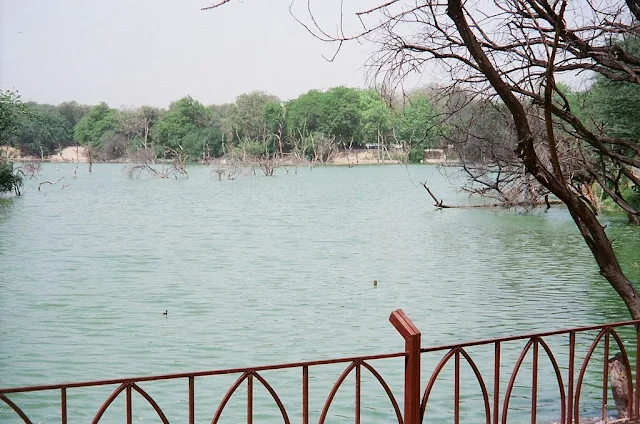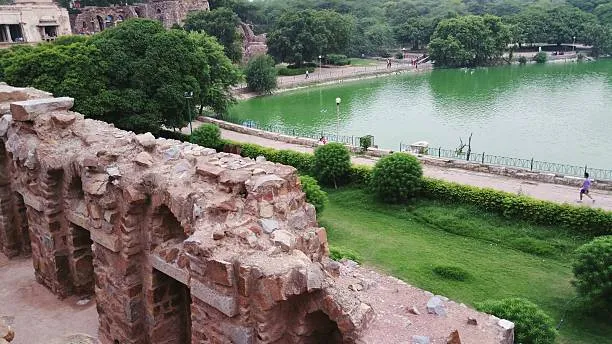Royal Tanks of Delhi: Hauz-i-Shamsi and Hauz-i-Khas
Hauz-i-Shamsi, also known as Hauz-i-Sultani, is a water tank (Hauz means tank or lake) built by Sultan Shams-ud-din Iltutmish in 1229. It is situated in Mehrauli, Delhi.
According to legend, when Sultan Shams-ud-din Iltutmish (r: 1211-1236) conceived the idea of building a reservoir, he sought the guidance of Khwaja Qutbuddin Bakhtiar Kaki to help him choose a suitable location. Iltutmish explored several places but was dissatisfied with all of them until he arrived at the current site of Hauz-i-Shamsi.
As night descended, the Sultan had a remarkable dream. In his vision, he saw the prophet mounted on a majestic horse, positioned right in the center of the chosen spot.
The prophet inquired, "Shams-ud-din, what you wish?" The Sultan humbly expressed his desire to excavate a reservoir. To his astonishment, the prophet commanded him to dig it right there. The prophet's horse struck its hoof, and water began to gush forth from the ground.
The Sultan awoke from his slumber and hurriedly went to Khwaja Qutbuddin to recount what had transpired. The Sultan took him to the spot, and with the aid of a lamp, they witnessed a spring that had emerged.
As the Hauz-i-Shamsi was occasionally dry, Ala-ud-din Khilji (r: 1296-1316) undertook its repair in 1311. The Sultan ordered the removal of sand and mud from the tank's bottom, erected a pavilion, and constructed a grand dome over it.
The following is a description of the Hauz-i-Shamsi given by the renowned traveler Ibn Battuta, who visited Delhi in 1334 during the reign of Sultan Muhammad Bin Tughlaq (r: 1325-1350). According to Battuta, the tank stretches approximately two miles in length and one mile in breadth.
"Outside Delhi is a big reservoir called after Sultan Shams-ud-din Iltutmish. The inhabitants of Delhi take their supply of drinking water from it, and it lies near the Idgah of Delhi. On its western side facing the Idgah are built platforms of stone, one higher than another. Under each platform are stairs which help one to get down to the water. Beside each platform is a dome of stone containing seats for amusement and pleasure seekers. In the middle of the tank there is a big dome of two storeys built of sculptured stone."
"When water rises high in the tank the dome can be reached only by boats, but when the water decreases people walk up to it. Inside the dome is a mosque where one finds fakirs most of the time. When the water on the sides of the tank gets dried up sugarcane, cucumber, sweet calabash, melons and water-melons are grown in it."
Later, during the reign of Firoz Shah Tughlaq (r: 1351-1388), the tank was repaired. Firoz Shah says in his Memoirs, "Some dishonest people had obstructed the channels supplying the Hauz-i-Shamsi and so impeded the flow of water. I severely punished these shameless and foolish people and had the supply channels reopened and the Hauz-i-Shamsi filled again. The Hauz-i-Shamsi became like a river of sweet water on account of abundance of water."
Hauz-i-Khas, also known as Hauz-i-Alai, is a water tank constructed by Sultan Ala-ud-din Khilji for the use of the inhabitants of Siri, a new city built by him. It is located in the Hauz Khas Complex in South Delhi. According to Ibn Battuta, this tank surpasses Sultan Shams-ud-din's tank in size, boasting around forty domes adorning its sides.
Over time, the Hauz-i-Alai fell into disrepair, and it was repaired by Firoz Shah Tughlaq. He says, "People had filled up the Hauz-i-Alai so that for a generation there had been no water in it. Indeed, the inhabitants of the city cultivated their crops there, dug wells and sold water from them, I had it dug out again so that the great reservoir is once more filled with water year after year."
Firoz Shah also built several remarkable buildings on the southern and eastern banks of the tank, now collectively known as the Hauz Khas Complex.
Timur mentions this tank in his autobiography. Following his triumph over Sultan Mahmud Tughlaq, Timur established his court at the Hauz Khas village: "This is a reservoir, which was constructed by Sultan Firoz Shah, and is faced all round with stone and cement. Each side of that reservoir is more than a bow-shot long, and there are buildings placed around it. This tank is filled by the rains in the rainy season, and it supplies the people of the city with water throughout the year."
Recent reports indicate that artificial islands have been deployed on the Hauz-i-Khas to absorb pollutants from the lake. However, it is disheartening to note that the Hauz-i-Shamsi has been utilized as a dumping ground by the locals for many years.
An article published in The Hindu in 2015 reveals that after a long absence, four to five pairs of common moorhen and 15-20 ducks have returned to the area.
According to legend, when Sultan Shams-ud-din Iltutmish (r: 1211-1236) conceived the idea of building a reservoir, he sought the guidance of Khwaja Qutbuddin Bakhtiar Kaki to help him choose a suitable location. Iltutmish explored several places but was dissatisfied with all of them until he arrived at the current site of Hauz-i-Shamsi.
As night descended, the Sultan had a remarkable dream. In his vision, he saw the prophet mounted on a majestic horse, positioned right in the center of the chosen spot.
The prophet inquired, "Shams-ud-din, what you wish?" The Sultan humbly expressed his desire to excavate a reservoir. To his astonishment, the prophet commanded him to dig it right there. The prophet's horse struck its hoof, and water began to gush forth from the ground.
The Sultan awoke from his slumber and hurriedly went to Khwaja Qutbuddin to recount what had transpired. The Sultan took him to the spot, and with the aid of a lamp, they witnessed a spring that had emerged.
As the Hauz-i-Shamsi was occasionally dry, Ala-ud-din Khilji (r: 1296-1316) undertook its repair in 1311. The Sultan ordered the removal of sand and mud from the tank's bottom, erected a pavilion, and constructed a grand dome over it.
The following is a description of the Hauz-i-Shamsi given by the renowned traveler Ibn Battuta, who visited Delhi in 1334 during the reign of Sultan Muhammad Bin Tughlaq (r: 1325-1350). According to Battuta, the tank stretches approximately two miles in length and one mile in breadth.
"Outside Delhi is a big reservoir called after Sultan Shams-ud-din Iltutmish. The inhabitants of Delhi take their supply of drinking water from it, and it lies near the Idgah of Delhi. On its western side facing the Idgah are built platforms of stone, one higher than another. Under each platform are stairs which help one to get down to the water. Beside each platform is a dome of stone containing seats for amusement and pleasure seekers. In the middle of the tank there is a big dome of two storeys built of sculptured stone."
"When water rises high in the tank the dome can be reached only by boats, but when the water decreases people walk up to it. Inside the dome is a mosque where one finds fakirs most of the time. When the water on the sides of the tank gets dried up sugarcane, cucumber, sweet calabash, melons and water-melons are grown in it."
Later, during the reign of Firoz Shah Tughlaq (r: 1351-1388), the tank was repaired. Firoz Shah says in his Memoirs, "Some dishonest people had obstructed the channels supplying the Hauz-i-Shamsi and so impeded the flow of water. I severely punished these shameless and foolish people and had the supply channels reopened and the Hauz-i-Shamsi filled again. The Hauz-i-Shamsi became like a river of sweet water on account of abundance of water."
Hauz-i-Khas, also known as Hauz-i-Alai, is a water tank constructed by Sultan Ala-ud-din Khilji for the use of the inhabitants of Siri, a new city built by him. It is located in the Hauz Khas Complex in South Delhi. According to Ibn Battuta, this tank surpasses Sultan Shams-ud-din's tank in size, boasting around forty domes adorning its sides.
Over time, the Hauz-i-Alai fell into disrepair, and it was repaired by Firoz Shah Tughlaq. He says, "People had filled up the Hauz-i-Alai so that for a generation there had been no water in it. Indeed, the inhabitants of the city cultivated their crops there, dug wells and sold water from them, I had it dug out again so that the great reservoir is once more filled with water year after year."
Firoz Shah also built several remarkable buildings on the southern and eastern banks of the tank, now collectively known as the Hauz Khas Complex.
Timur mentions this tank in his autobiography. Following his triumph over Sultan Mahmud Tughlaq, Timur established his court at the Hauz Khas village: "This is a reservoir, which was constructed by Sultan Firoz Shah, and is faced all round with stone and cement. Each side of that reservoir is more than a bow-shot long, and there are buildings placed around it. This tank is filled by the rains in the rainy season, and it supplies the people of the city with water throughout the year."
Recent reports indicate that artificial islands have been deployed on the Hauz-i-Khas to absorb pollutants from the lake. However, it is disheartening to note that the Hauz-i-Shamsi has been utilized as a dumping ground by the locals for many years.
An article published in The Hindu in 2015 reveals that after a long absence, four to five pairs of common moorhen and 15-20 ducks have returned to the area.




Comments